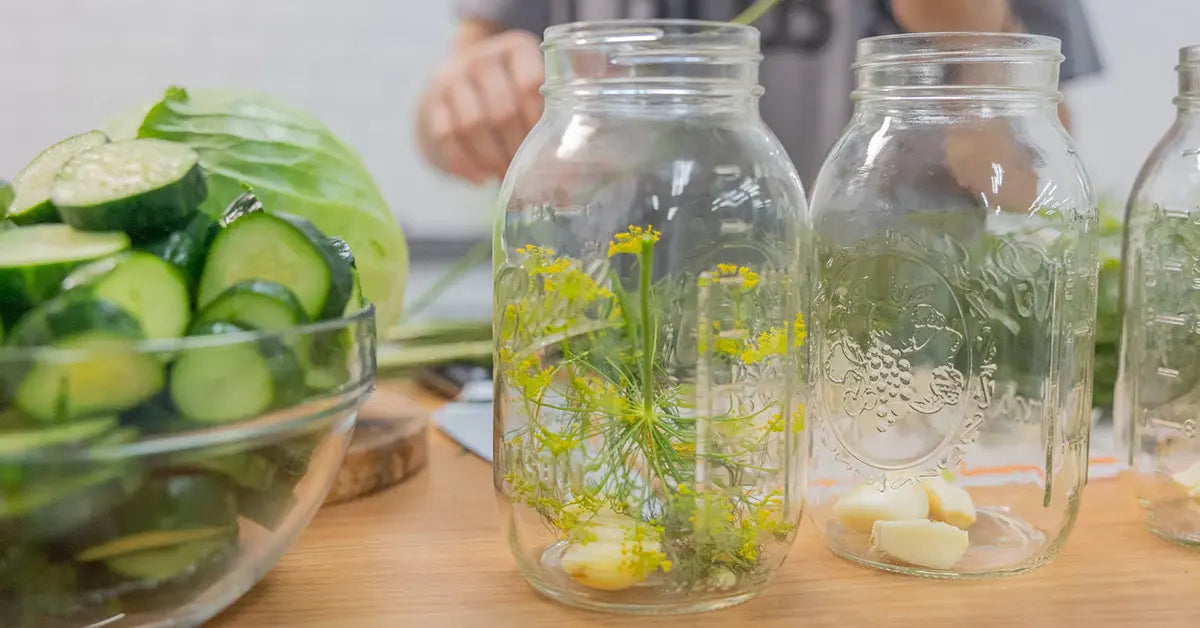
These fermented pickles are not necessarily kosher in the sense that they complies with Jewish food laws. This fermented pickle recipe is called kosher because of its flavor profile made popular by New York’s Jewish pickle makers, known for their natural salt-brined pickles heavily seasoned with dill and garlic. So any pickle that is seasoned in the same fashion is referred to as a kosher dill.
Fermented pickles have been around for hundreds of years and we have the best fermented pickle recipe for you to follow to start making your own pickles.
15 minutes
672 hours
1/2-gallon jar
INGREDIENTS AND EQUIPMENT AVAILABLE AT CULTURES FOR HEALTH
Pickle Kit

Pickle Making Kit
$35.99
As seen on Insider.com
Make crunchy, tasty pickles at home with our DIY Pickle Kit!
This kit is also great for making kimchi, sauerkraut, and other fermented vegetables! Equipment in the kit may appear different than pictured.
Celtic Sea Salt Light Grey (Course) 1/4 lb
Real fermented pickles are a wonderful culinary journey, different from the world of quick pickling where people simply soak cucumbers in vinegar. A good, lacto fermented pickle recipe harnesses the natural bacteria in the environment to create an acidic environment perfect for fermenting dill pickles.
After trying a variety of techniques, we've crafted our very own fermented pickle recipe we're thrilled to share with you. And, since this uses the natural bacteria in your environment, your fermented pickles will possess a distinct flavor unique to your location. You'll be crafting your very own unique fermented pickles recipe.

Download our Lacto-Fermentation Recipe book today and embark on the journey of making your fermented pickles at home. In addition to enjoying the scrumptious flavor, you'll benefit from the healthful probiotics, enzymes, and vitamins created during the fermentation process.
WHAT EXACTLY IS LACTO-FERMENTATION FOR PICKLES?
Lacto-fermentation, the process at the heart of our fermented pickle recipe, is a type of fermentation that utilizes lactic-acid-producing bacteria to break down the sugar in foods. The easiest way to lacto-ferment pickles is by adding brine to food that naturally contains lactic acid bacteria, such as cucumbers. This lactic acid bacteria creates an acidic brine, giving you deliciously fermented pickles.
INGREDIENTS FOR HOMEMADE FERMENTED PICKLES:
- 4-6 grape, oak, horseradish, or bay leaves
- 6-9 cloves garlic, peeled
- 2 large heads of dill
- Spices to taste: black peppercorns, red pepper flakes, mustard seeds, etc. (Secret ingredient: for an extra bite, add a few strips of fresh horseradish to the spice mix!) we recommendpickling spices
- Enough pickling cucumbers to fill a ½-gallon jar
INGREDIENTS FOR LACTO FERMENTED PICKLE BRINE
- 1 ½ cups distilled white vinegar (you can also use apple cider vinegar)
- 2 cups of chlorine-free water
- ¼ cup sugar
- 4 tsp of kosher salt

INSTRUCTIONS FOR FERMENTED PICKLE RECIPE:
- Make a brine by dissolving 4 tablespoons sea salt in 2 cups of chlorine-free water. (Note: this recipe might make more brine than what is needed, you can save the extra brine for future ferments.)
- In ahalf-gallon jar add a couple of the tannin-containing leaves, a few cloves of garlic, the heads of dill, and ⅓ of the spices.
- Learning how to ferment pickles is an exciting process. To start, pack half of the cucumbers tightly on top of the spices. (The longest ones work best at the bottom.)
- Repeat a layer of leaves, garlic, and spices. Then, add another tightly packed layer of cucumbers and top them off with more garlic and spices.
- Pour the pickling brine over the pickles, leaving 1-2 inches of headspace. Place another tannin-containing leaf on top of the pickles as a cover between the pickles and the surface of the brine. Use a fermentation weight to keep the pickles under the liquid, if necessary. Cover the jar with a tight lid, airlock lid, or coffee filter secured with a rubber band.
- Ferment at room temperature (60-70°F is preferred) until your desired flavor and texture are achieved. If using a tight lid, burp daily to release excess pressure. The brine should turn cloudy and bubbly, and the pickles should taste sour when done.
- You can consume your lacto fermented pickles right away, or store in a refrigerator or root cellar to enjoy them throughout winter.

HOW TO START FERMENTING PICKLES AT HOME WITH CULTURES FOR HEALTH
Cultures for Health offers the best resources for you to begin your journey of making your own fermented pickles at home. From all of the tools to pickle kits, fermentation kits and culture packs, we provide everything you need to effortlessly start making your own food at home.
The best place to start is ourPickle Kit. This kit includes everything you need to successfully start fermenting pickles including:
- Half-GallonFermentation Jar
- Airlock Lid fitted with rubber grommets
- Ceramic Fermentation Weights
- Celtic Sea Salt
- Recipe cards
These fermentation supplies are versatile and perfect not only for pickles but also for making sauerkraut and a range of other fermented vegetables, including kimchi, celebrated for its myriad of health benefits.
Our Lacto-Fermentation Guide and Recipe Book will show you how easy it is to start making your Fermented Pickles. Download it today!
Ready to Learn More?
















